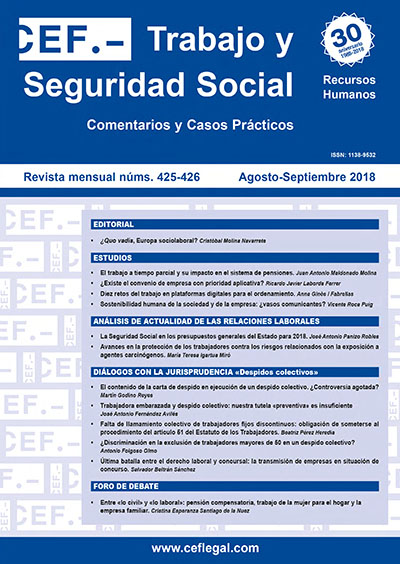Progress in the protection of workers from the risks related to exposure to carcinogens or mutagens at work: some notes on Directive (EU) 2017/2398 of the European Parliament and the Council, of 12 December 2017
DOI:
https://doi.org/10.51302/rtss.2018.1546Keywords:
carcinogens and mutagens, precautionary principle, limit values, health monitoringAbstract
Prevention in the field of cancer of occupational origin or suspected to be work-related is currently at the top of the european agenda. In addition to more focused prevention in the fight against work-related diseases, there are specific measures to protect health and safety against carcinogens or mutagens. Protection in this area focuses on the setting of limit values. Directive 2017/2398 represents a significant step forward in terms of the number of actors involved and the setting of stricter values. However, the connection of this area of health and safety with scientific and technological progress means that it has also been considered appropriate to refer to the precautionary principle, which must inspire the Union’s action in its unstoppable efforts to constantly improve health and safety conditions at work. Nevertheless, in the field of business, the principle must be defined with regard to the demanding duties of business to avoid, replace and assess the risk of exposure to carcinogens. In this sense, the Directive affects relevant aspects already in force in national law, such as the extension of health surveillance beyond the end of exposure or the need to continue to make progress in research, prevention and protection of workers’ right to reproduction.
Downloads
References
Benavides, F. G., Menéndez, A., Declòs, J. y Luque, M. (2012). Evidencia científica y responsabilidad legal en salud laboral: recargo de prestaciones por falta de medidas de seguridad e higiene tras la muerte por mesotelioma de un trabajador. Archivos de Prevención de Riesgos Laborales, 15(2), 86-89.
Cierco Seira, C. (2004). El principio de precaución: reflexiones sobre su contenido y alcance en los derechos comunitario y español. Revista de Administración Pública, 163, 73-125.
European Trade Union Institute. (2017). The cost of occupational cancer in the EU-28. Bruselas: ETUI.
Fumero Dios, I. S. (2018). La Hoja de ruta de la Unión Europea sobre agentes carcinógenos en el trabajo. Trabajo y Derecho, 40, 68-80.
Jáuregui Medina, J. (2013). La construcción histórica del principio de precaución como respuesta al desarrollo científico y tecnológico. Revista Internacional de Éticas Aplicadas (DILEMATA), 11, 1-19.
Moreno Marcos, M. (2007). El principio de precaución en torno a la salud y seguridad de los trabajadores en Europa: propuestas para el debate. Derecho del Trabajo, 4, 265-290.
Muñoz Ruíz, A. B. (2010). Nuevos estándares judiciales en el derecho comunitario de la seguridad y salud en el trabajo: el principio de precaución o cautela. En Los mercados laborales y las políticas sociales en Europa (pp. 689-703). Madrid: Ministerio de Trabajo y Asuntos Sociales.
Muñoz Ruíz, A. B. (2011). Los riesgos del desarrollo como límite del deber de seguridad empresarial. Revista Doctrinal Aranzadi Social, 3(16), 49-55.
Rodríguez López, B. (2013). ¿Cuánta ignorancia? El principio de precaución y la falta de certeza absoluta. Azafea. Revista de Filosofía, 15, 221-239.
Sanz Baos, P. (2004). Los principios de prevención y de cautela en el derecho ambiental. Revista Jurídica de la Comunidad de Madrid, 19, 1-11.
Segura, A. (2003). El conocimiento científico y el principio de precaución en salud laboral. Archivos de Prevención de Riesgos Laborales, 6(4), 154-157.


















